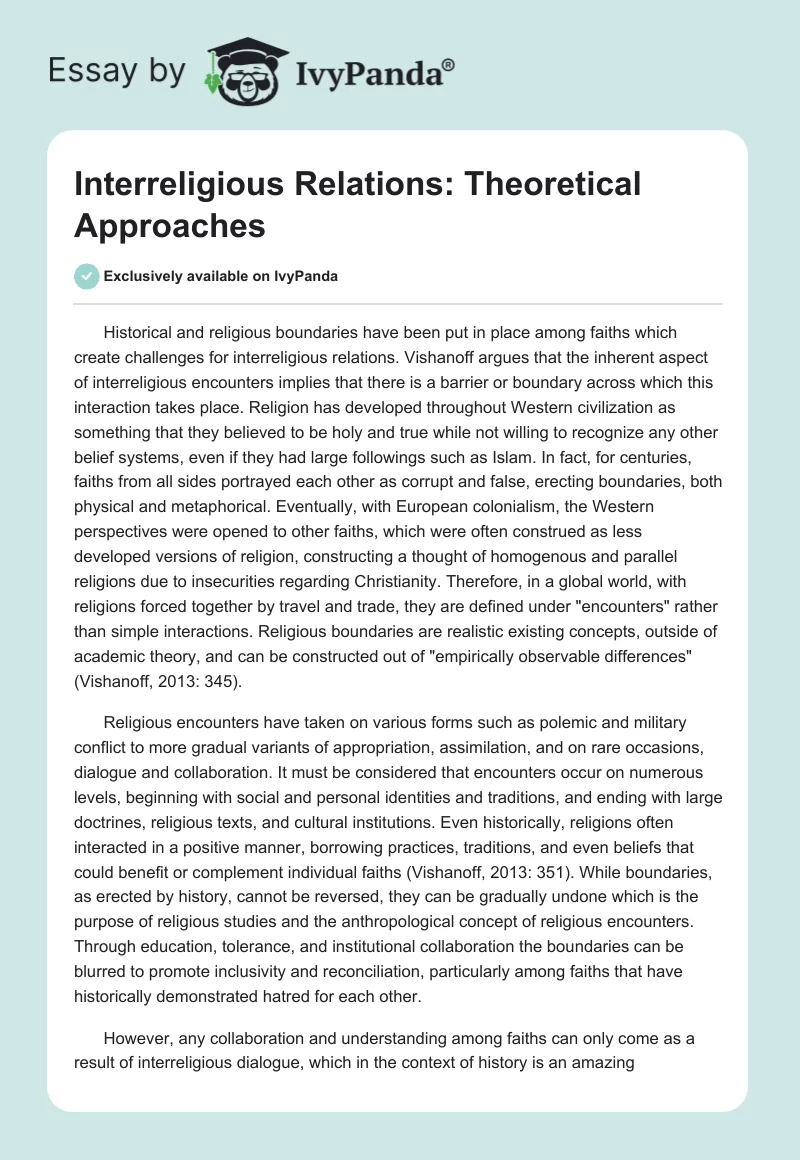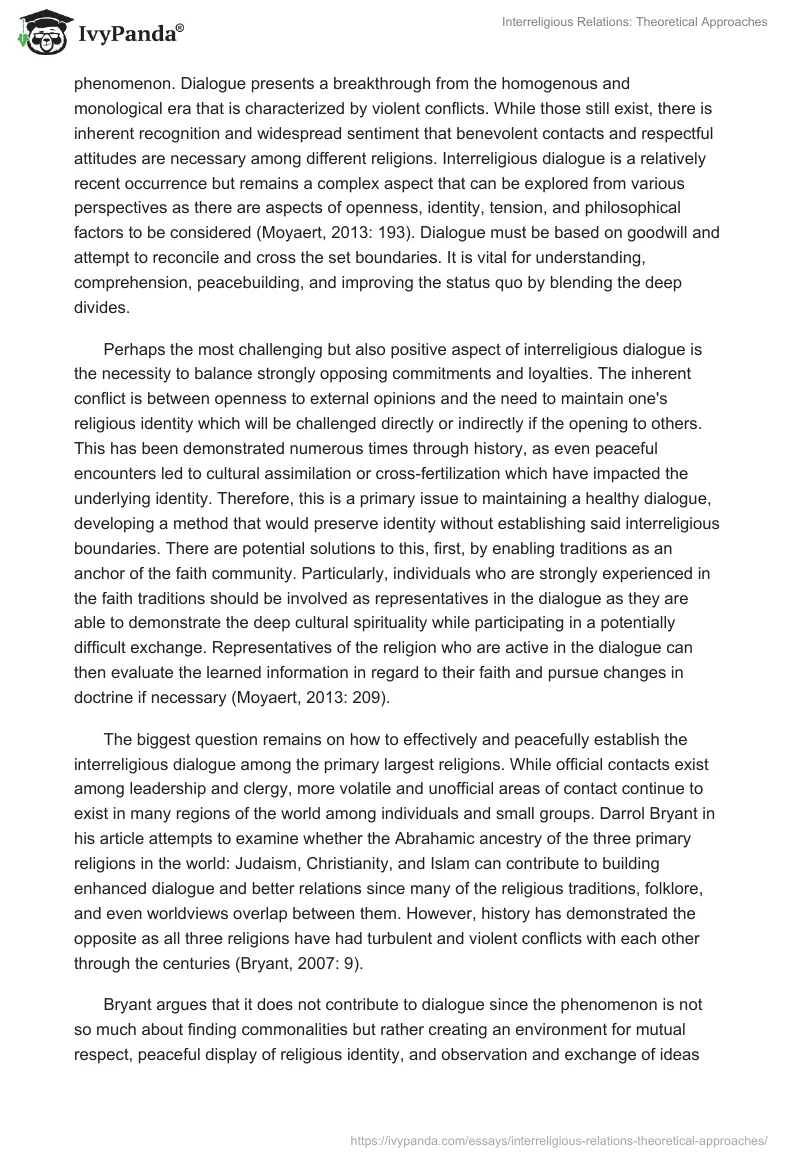Historical and religious boundaries have been put in place among faiths which create challenges for interreligious relations. Vishanoff argues that the inherent aspect of interreligious encounters implies that there is a barrier or boundary across which this interaction takes place. Religion has developed throughout Western civilization as something that they believed to be holy and true while not willing to recognize any other belief systems, even if they had large followings such as Islam. In fact, for centuries, faiths from all sides portrayed each other as corrupt and false, erecting boundaries, both physical and metaphorical. Eventually, with European colonialism, the Western perspectives were opened to other faiths, which were often construed as less developed versions of religion, constructing a thought of homogenous and parallel religions due to insecurities regarding Christianity. Therefore, in a global world, with religions forced together by travel and trade, they are defined under “encounters” rather than simple interactions. Religious boundaries are realistic existing concepts, outside of academic theory, and can be constructed out of “empirically observable differences” (Vishanoff, 2013: 345).
Religious encounters have taken on various forms such as polemic and military conflict to more gradual variants of appropriation, assimilation, and on rare occasions, dialogue and collaboration. It must be considered that encounters occur on numerous levels, beginning with social and personal identities and traditions, and ending with large doctrines, religious texts, and cultural institutions. Even historically, religions often interacted in a positive manner, borrowing practices, traditions, and even beliefs that could benefit or complement individual faiths (Vishanoff, 2013: 351). While boundaries, as erected by history, cannot be reversed, they can be gradually undone which is the purpose of religious studies and the anthropological concept of religious encounters. Through education, tolerance, and institutional collaboration the boundaries can be blurred to promote inclusivity and reconciliation, particularly among faiths that have historically demonstrated hatred for each other.
However, any collaboration and understanding among faiths can only come as a result of interreligious dialogue, which in the context of history is an amazing phenomenon. Dialogue presents a breakthrough from the homogenous and monological era that is characterized by violent conflicts. While those still exist, there is inherent recognition and widespread sentiment that benevolent contacts and respectful attitudes are necessary among different religions. Interreligious dialogue is a relatively recent occurrence but remains a complex aspect that can be explored from various perspectives as there are aspects of openness, identity, tension, and philosophical factors to be considered (Moyaert, 2013: 193). Dialogue must be based on goodwill and attempt to reconcile and cross the set boundaries. It is vital for understanding, comprehension, peacebuilding, and improving the status quo by blending the deep divides.
Perhaps the most challenging but also positive aspect of interreligious dialogue is the necessity to balance strongly opposing commitments and loyalties. The inherent conflict is between openness to external opinions and the need to maintain one’s religious identity which will be challenged directly or indirectly if the opening to others. This has been demonstrated numerous times through history, as even peaceful encounters led to cultural assimilation or cross-fertilization which have impacted the underlying identity. Therefore, this is a primary issue to maintaining a healthy dialogue, developing a method that would preserve identity without establishing said interreligious boundaries. There are potential solutions to this, first, by enabling traditions as an anchor of the faith community. Particularly, individuals who are strongly experienced in the faith traditions should be involved as representatives in the dialogue as they are able to demonstrate the deep cultural spirituality while participating in a potentially difficult exchange. Representatives of the religion who are active in the dialogue can then evaluate the learned information in regard to their faith and pursue changes in doctrine if necessary (Moyaert, 2013: 209).
The biggest question remains on how to effectively and peacefully establish the interreligious dialogue among the primary largest religions. While official contacts exist among leadership and clergy, more volatile and unofficial areas of contact continue to exist in many regions of the world among individuals and small groups. Darrol Bryant in his article attempts to examine whether the Abrahamic ancestry of the three primary religions in the world: Judaism, Christianity, and Islam can contribute to building enhanced dialogue and better relations since many of the religious traditions, folklore, and even worldviews overlap between them. However, history has demonstrated the opposite as all three religions have had turbulent and violent conflicts with each other through the centuries (Bryant, 2007: 9).
Bryant argues that it does not contribute to dialogue since the phenomenon is not so much about finding commonalities but rather creating an environment for mutual respect, peaceful display of religious identity, and observation and exchange of ideas (Bryant, 2007: 24). Therefore, in building interfaith dialogue, it should not be emphasized that these religions are identical as many pundits attempt to do, as this may actually insult and push away representatives from peacebuilding. Instead, the quest should be focused on highlighting and respecting identities and encouraging cooperation through the deep understanding of history and tradition that the religions do share.
In the context of interreligious dialogue, Suomala makes an interesting observation that while such encounters are commonly structured with representatives from each faith, they fail to consider large groups of people that identify themselves with traditions from several religions. She describes an anecdote from the novel Life of Pi where the protagonist is directly associated with a Hindu-Muslim-Christian identity and while religious leaders recognize this, the discussion gradually transitions into a debate on which faith is more superior. Therefore, these populations and communities that adhere to various religious identities are excluded from the dialogue which is not always correct. Multiethnic countries such as the United States have a complex religious identity since people may be born into mixed intercultural families as well as having the freedom to choose their faith (Suomala, 2012: 360). As a result, this scenario offers a differing perspective on interreligious dialogue in the modern world. The necessity of inclusivity for all samples of interfaith individuals is vital to mutual understanding and compassion as these individuals can bridge the divide between homogeneous traditions.
Finally, the discussion leads as to how to implement interreligious dialogue in modern settings. A source studies in the Encountering Religion course by Eboo Patel examines religious diversity on a college campus and how cooperation was enabled there through interfaith dialogue included. Colleges have taken on an ideological and institutionalized attempt to promote inter-religious engagement through higher education, communication, and mutually respectful environments. This is done through enabling discussions, building partnerships, creating interfaith organizations, establishing support programs, and institutional recognition of this environment (Patel, 2007: 2). As a result, this has influenced change and promoted dialogue not just on campus, but outside of it as well, as students took this approach into the real world and professional or personal lives after graduating, demonstrating the potential success of such tools for breaking down boundaries among religions.
Works Cited
Bryant, Darrol M. “The Abrahamic Faiths and the Quest for Dialogue: Does Common Ancestry Make for Good Relations?” Dialogue & Alliance, vol. 21, no. 1, 2007, pp. 9-25.
Moyaert, Marienne. “Interreligious Dialogue.” Understanding Interreligious Relations, edited by David Cheetham, Douglas Pratt, and David Thomas, Oxford University Press, 2013, pp. 193-217.
Patel, Eboo. “Religious Diversity and Cooperation on Campus.” Journal of College and Character, vol. 9, no. 2, 2007, pp. 1-8.
Vishanoff, David. “Boundaries and Encounters.” Understanding Interreligious Relations, edited by David Cheetham, Douglas Pratt, and David Thomas, Oxford University Press, 2013, pp. 341-364.


